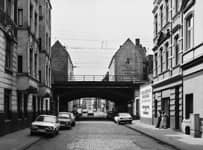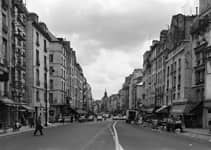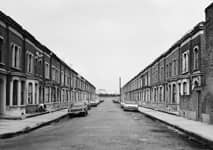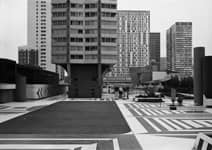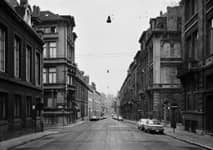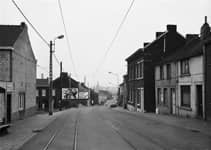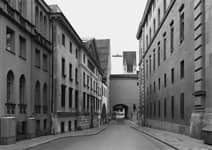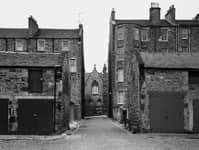Through 1979, he continued to photograph the streets in Düsseldorf and also for the first time in other European cities including Cologne, Munich, Brussels, Charleroi and Paris. After the concentrated experience of working in different parts of New York City, the process of identifying locations which expressed most clearly the nature of the city became more precise. Struth now worked with greater precision and economy. He spent more time looking for the single location which could “summarise a city” and made comparatively few photographs in each city—no more than five in Charleroi, for example, or ten in Munich.
Towards the end of 1979 Struth travelled to Paris to visit Thomas Schütte, a fellow student at the Kunstakademie Düsseldorf, who had a residency in Paris. Schütte suggested looking at the Beaugrenelle project in Paris, a huge urban development for mixed commercial and residential use with several distinctive high-rise towers built on the banks of the Seine in the 1970s.
In 1980 Rüdiger Schöttle invited Struth to make an exhibition of the Beaugrenelle photographs at his gallery in Munich. The exhibition consisted of thirty-seven photographs, presented together with the architectural plan of the complex as well as the advertising brochures published by the developer. Struth recalls the exhibition as “quite a laconic presentation, perhaps a bit didactic but nonetheless not well understood.”
The ongoing project to investigate the differing nature of urban spaces in European cities was interrupted in the early 1980s by an obligatory period of civilian service where Struth ran a small print shop in a community centre in Düsseldorf. Following this hiatus, Struth resumed his work with a trip to Rome.
Upon seeing his exhibition at Galerie Rüdiger Schöttle in Munich in 1985, Ulrich Loock invited Struth to make a first major survey of his city pictures at the Kunsthalle Bern. The exhibition offered the first significant opportunity to orchestrate an experience of the work through a sequence of space, and in total comprised one hundred black-and-white and colour photographs. In the large central room at the Kunsthalle Bern, fourteen works which Struth considered to be “the most complete, the most emblematic, the ones which conveyed something more general about the cities they were made in— the pictures Loock and I called ‘the headlines’—were installed: Crosby Street, New York; Düsselstrasse, Düsseldorf; Rue St. Antoine, Paris. The rooms around were organised around bodies of work from different subjects: Beaugrenelle, Japan, individual buildings, etc.”
“Why do cities look the way they do? You can’t always say it is the responsibility of the architect or the mayor or the politicians; ultimately it’s our responsibility. Since the work in Tower Hamlets in East London in 1976 and at Beaugrenelle in Paris in 1979–81, I had been thinking about this question of responsibility in the portrayal of urban space. It was a central part of the consciousness of growing up in the 1950s and 60s, the confrontation with my parents’ generation, with Germany’s past, interrogating the structures and realities of dictatorship, capitalism and communism, which inevitably led to the question of individual and collective responsibility for the factual.”

